Introduction
The construction industry is rapidly adopting digital ERP platforms to manage complex projects, assets, budgets, and multi-site operations with greater control and visibility. Odoo for Construction unifies project management, equipment tracking, finance, and site operations into a single intelligent system, enabling teams to deliver projects on time, within budget, and in compliance with industry standards. Organizations looking to scale with confidence can partner with a trusted Odoo Development Company to unlock enterprise-ready construction solutions.
1. Digital Transformation in Construction with Odoo for Construction

Construction projects require tight coordination across engineers, site managers, contractors, accountants, procurement teams, and equipment operators. Fragmented tools and manual workflows lead to cost overruns, delays, miscommunication, and compliance challenges. Odoo for Construction solves these problems by providing a unified ERP ecosystem that integrates planning, scheduling, budgeting, equipment usage, document control, and real-time site monitoring. Moreover, its modular design supports both small contractors and large construction enterprises.
Unified Construction Operations Across Sites, Teams & Departments
Construction companies often manage multiple project sites simultaneously, each with different schedules, resources, and compliance requirements. Odoo centralizes these operations through:
- Project dashboards with real-time progress updates
- Site-wise task tracking and workforce allocation
- Material and equipment visibility across locations
- Communication channels that connect field teams and office departments
- Automated workflows for approvals and change requests
Additionally, executives gain complete visibility into performance across all active projects.
Automation Driving Efficiency, Accuracy & Cost Control
Manual processes significantly slow down construction execution. Odoo automates critical workflows such as:
- Task scheduling and crew assignments
- Material requisition and purchase approvals
- Site inspections and maintenance alerts
- Real-time cost tracking
- Compliance documentation and reporting
Consequently, project managers reduce administrative burden and maintain tighter control over timelines and budgets.
Scalable Architecture for Contractors, Builders & Infrastructure Firms
Whether a business handles residential projects or large-scale infrastructure, Odoo for Construction adapts effortlessly.
Scalability Advantages
- Multi-project management under one platform
- Cloud-ready system for on-site and remote access
- Customizable modules for procurement, HR, safety, and engineering
- Standardized SOPs across all projects
- Real-time coordination between headquarters and field workers
This flexibility supports long-term growth without requiring system replacements.
2. End-to-End Project Lifecycle Management with Odoo for Construction
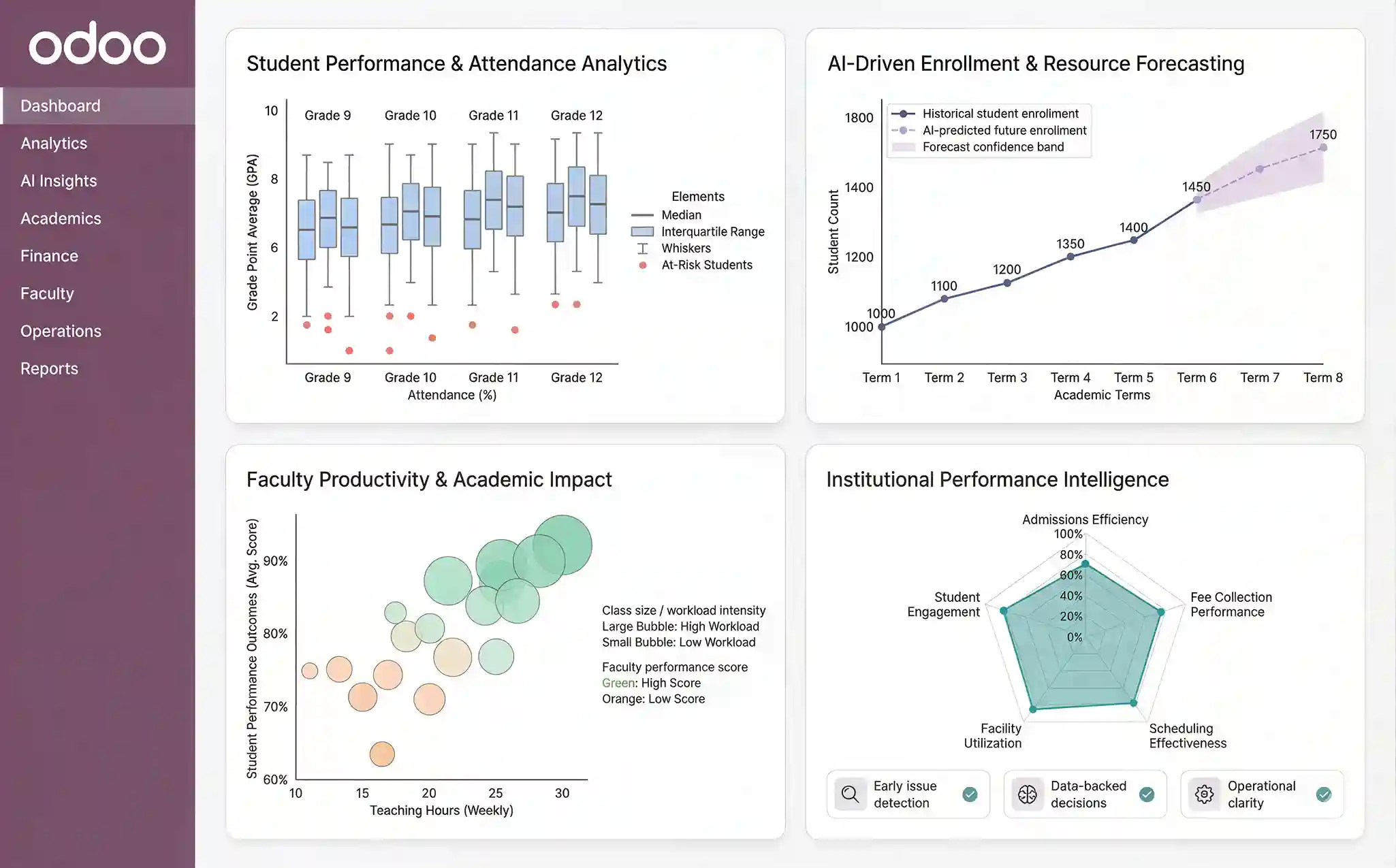
Odoo for Construction centralizes project management by integrating scheduling, procurement, equipment, budgeting, documentation, and contractor coordination into one real-time platform. By automating workflows and improving visibility across all project phases, Odoo helps reduce cost overruns, prevent delays, and maintain full operational control. Its modular architecture enables construction firms to scale efficiently across multiple job sites.
Construction Project Planning, Task Dependencies & Execution Oversight
Odoo centralizes the entire planning and execution lifecycle, ensuring smooth coordination between engineering, procurement, and site teams.
Key Planning Capabilities
- Gantt charts for dependency-based scheduling
- Kanban boards for real-time task updates
- Milestone tracking and automated alerts
- Subcontractor task allocation and status reporting
- Field notes and on-site updates logged instantly
Odoo’s real-world benefits in project optimization are detailed in Streamlining Project Management in Construction with Odoo, illustrating how companies improve visibility and reduce rework.
Real-Time Equipment Tracking, Maintenance & Asset Utilization
Equipment mismanagement is a major cause of cost leakage in construction. Odoo ensures visibility and accountability across all machinery and tools.
Equipment Management Features
- GPS and IoT integration for real-time equipment location
- Usage tracking based on hours, mileage, or workload
- Predictive maintenance scheduling
- Automatic logs for breakdowns and downtime
- Allocation of equipment to specific sites or tasks
For deeper insights, refer to Odoo Solutions for Equipment Tracking in Construction, which highlights how Odoo prevents misuse and prolongs equipment life.
Scheduling Tools to Reduce Project Delays & Improve Workforce Productivity
Construction delays are often caused by scheduling conflicts, resource shortages, or misaligned dependencies. Odoo’s intelligent scheduling tools help mitigate these risks.
Scheduling Enhancements
- Automated crew allocation based on skill and availability
- Material delivery scheduling synced with project phases
- Weather-based adjustments and timeline recalculations
- Task prioritization with critical path visibility
- Alerts for upcoming bottlenecks or slow-progress tasks
A detailed guide on timeline optimization is provided in Reducing Construction Delays with Odoo Scheduling Tools.
Document Control, Blueprint Management & Compliance Tracking
Construction projects generate large volumes of documents—blueprints, safety forms, contracts, permits, RFIs, change orders, and inspection reports. Odoo brings structure and traceability to this documentation ecosystem.
Document Control Capabilities
- Centralized storage with secure access levels
- Version control for drawings and specifications
- Automated approvals for RFIs, change requests & submissions
- Compliance documentation for audits and site safety
- Mobile access for on-site supervisors
Learn more in Using Odoo for Document Control in Construction Projects, which explains how teams maintain consistency and avoid outdated documentation.
Budget Tracking, Cost Forecasting & Financial Control Across Sites
Construction budgets are dynamic and sensitive—incorrect tracking can cause major financial losses. Odoo integrates operational and financial workflows to ensure transparency.
Budget Management Features
- Budget allocation by project, phase, or activity
- Real-time cost vs. estimate comparisons
- Automated expense logs from procurement and site teams
- Vendor bill approvals and payment status visibility
- Profitability analytics per project
Detailed financial insights are available in Tracking Construction Project Budgets Using Odoo Accounting, showcasing how Odoo strengthens financial governance.
3. Transportation Management with Odoo for Logistics
| Area | Traditional Approach | Odoo for Construction |
|---|---|---|
| Scheduling | Manual, error-prone | Automated, dependency-based scheduling |
| Equipment | Poor visibility | Real-time tracking & maintenance |
| Document Control | Scattered files | Centralized version-controlled repository |
| Budgeting | Delayed reporting | Real-time cost & variance tracking |
| Project Updates | Phone calls & emails | Live dashboards across all sites |
4. Financial & Procurement Management with Odoo for Construction
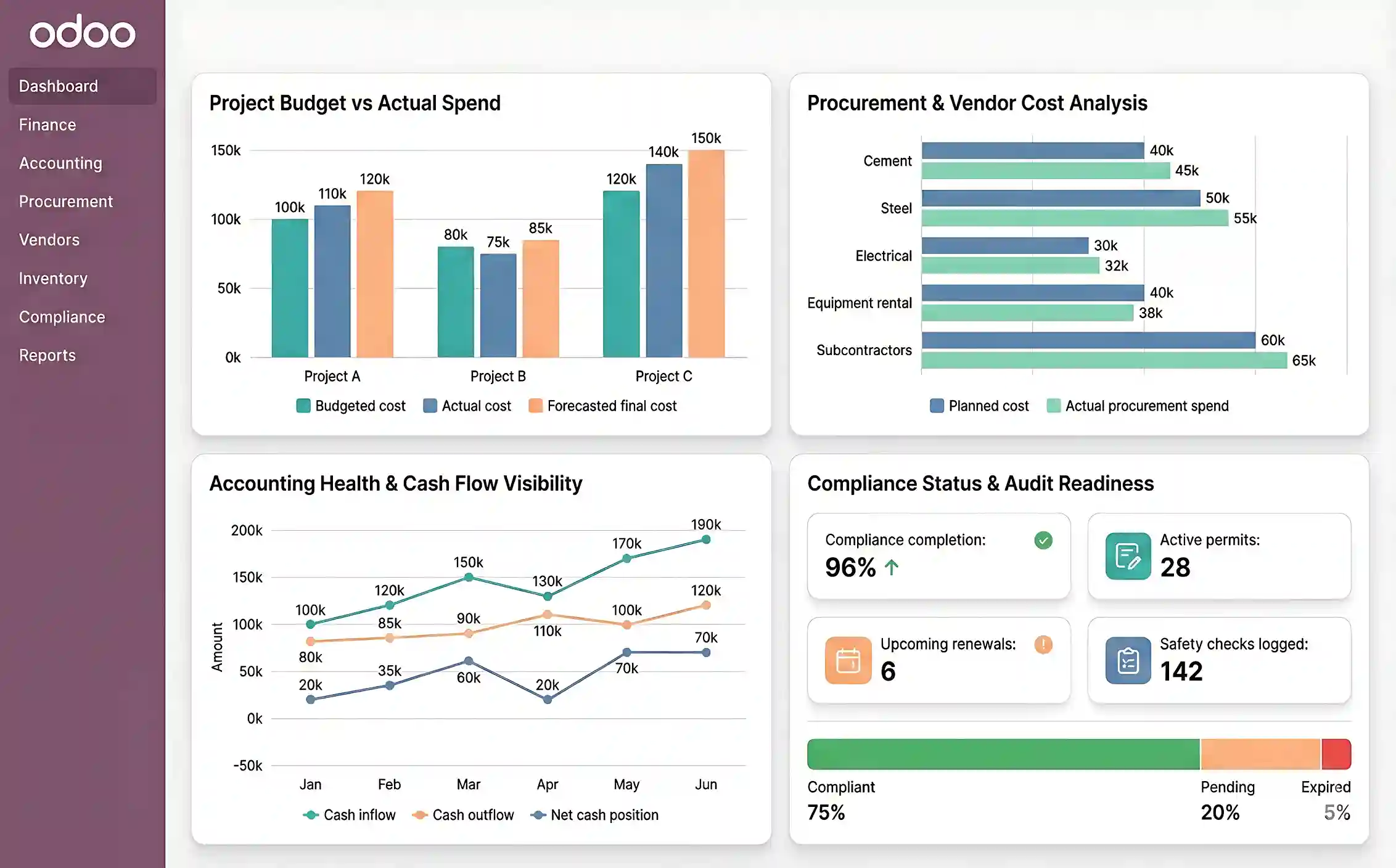
Odoo delivers real-time financial control by integrating budgeting, cost tracking, accounting, and operational workflows into one system. With automated expense management, transparent budgeting, and compliance-ready reporting, Odoo eliminates manual reconciliation and improves financial visibility. Real-time dashboards empower construction leaders to control costs, manage vendors, and make informed decisions.
Automated Project Budgeting, Cost Allocation & Real-Time Financial Tracking
Construction budgets evolve continuously as projects progress. Odoo ensures these changes are captured automatically.
Budgeting Features
- Budget allocation per project, phase, or milestone
- Automated cost updates from procurement, labor, and equipment modules
- Real-time cost-to-completion analysis
- Forecasting tools to identify future overruns
- Alerts for budget threshold breaches
For deeper insights, refer to Tracking Construction Project Budgets Using Odoo Accounting, which showcases accurate budget governance using Odoo.
Centralized Procurement, Vendor Management & Material Cost Control
Procurement in construction involves large volumes of materials and frequent coordination with suppliers. Odoo simplifies this with a structured procurement workflow.
Procurement Capabilities
- Material requisition from site teams
- Automated purchase orders and approvals
- Vendor comparison and price history tracking
- Delivery and invoice matching (3-way verification)
- Inventory sync for site-level stock monitoring
Additionally, procurement analytics help companies negotiate better pricing and minimize material wastage.
Comprehensive Accounting Suite for Construction Firms
Odoo’s accounting module is tailored to handle multi-project financials, subcontractor payments, revenue recognition, and expense allocation.
Accounting Strengths
- Automated journal entries
- Multi-company and multi-project financial consolidation
- Subcontractor billing and retention tracking
- Progress-based revenue recognition
- Asset depreciation for heavy machinery
- Bank sync and automated reconciliation
Furthermore, real-time dashboards provide a complete financial picture across sites, vendors, and projects.
Compliance Management, Audit-Ready Records & Regulatory Reporting
Construction companies must comply with safety standards, environmental regulations, contract obligations, and financial reporting guidelines. Odoo centralizes compliance and audit workflows.
Compliance Features
- Document retention for permits, licenses, and inspection reports
- Automated reminders for renewals and compliance deadlines
- Safety checklist tracking for on-site teams
- Digital audit logs for all operational and financial actions
- Tax reporting aligned with regional construction policies
Consequently, companies reduce compliance risks and ensure smoother external audits.
5. Field Operations & Workforce Productivity with Odoo for Construction
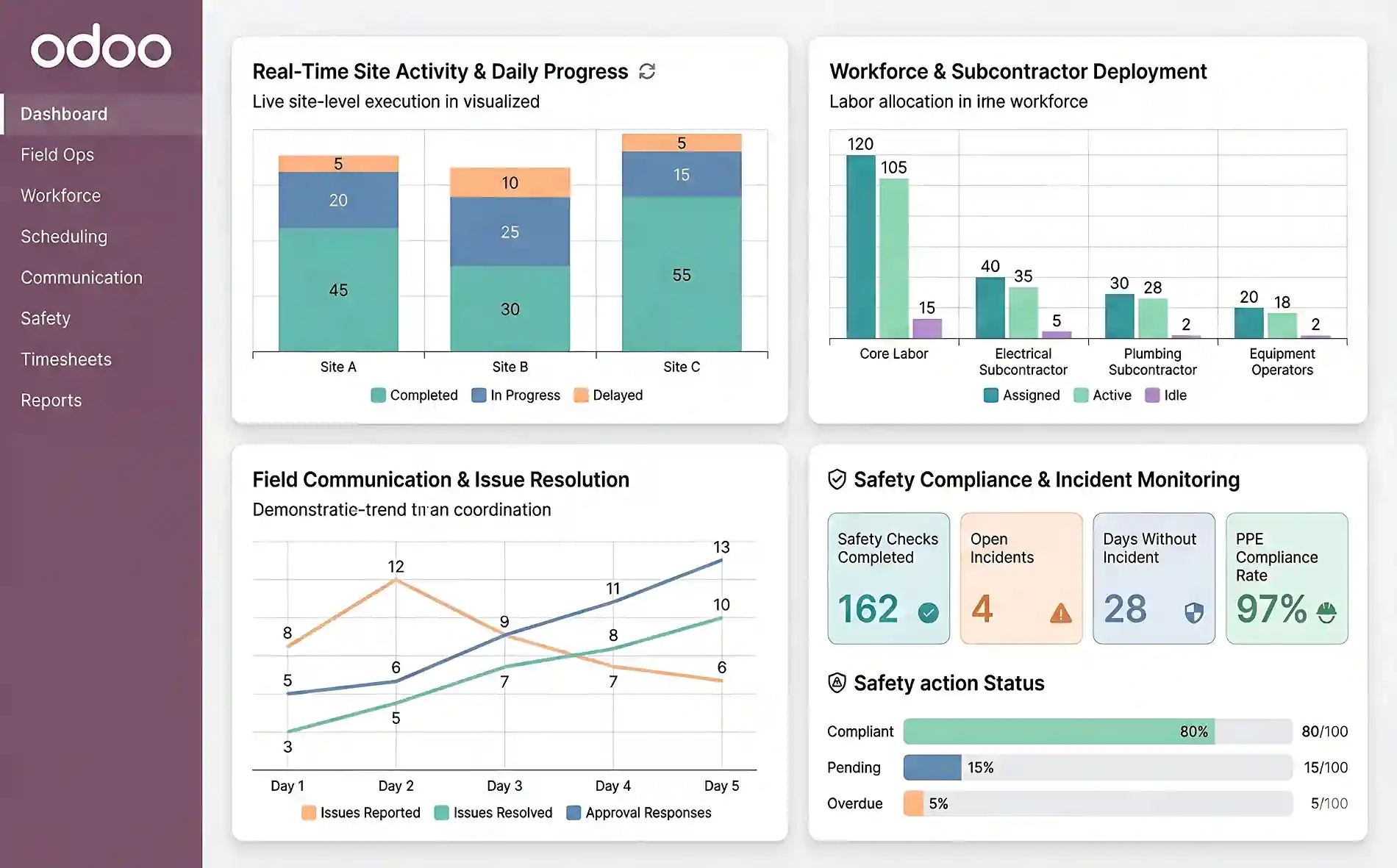
Odoo for Construction enhances project execution by connecting site supervisors, engineers, subcontractors, and back-office teams on a single digital platform. With real-time updates, centralized communication, and mobile access, Odoo improves field productivity, reduces delays, and supports safety compliance. Construction teams can track progress instantly and keep projects on schedule from any location.
Real-Time Field Updates, Daily Logs & Site-Level Visibility
On-site activities change rapidly material arrivals, task completion, inspections, weather delays, equipment breakdowns, or safety incidents. Odoo captures real-time updates to enhance situational awareness.
Field Operations Features
- Daily site reports submitted via mobile
- Live updates on task progress and issues
- Photo attachments for inspections and validations
- Real-time weather impact logs
- Automated alerts for deviations and delays
Additionally, supervisors and project managers gain continuous visibility into on-site activities without requiring physical presence at every location.
Workforce Scheduling, Labor Allocation & Subcontractor Coordination
Managing multiple subcontractors and labor teams is a major challenge in construction. Odoo streamlines this through structured scheduling tools.
Workforce Management Benefits
- Automated shift creation and workforce allocation
- Crew assignment based on project phase and skill level
- Subcontractor performance tracking and attendance logs
- Cost allocation per labor group or contractor
- Timesheet integration with payroll and project accounting
Consequently, companies reduce labor inefficiencies and significantly minimize workforce-related delays.
Communication Tools for Seamless Collaboration Between Office & Field Teams
Miscommunication causes rework, delays, and cost overruns. Odoo centralizes communication across engineering, procurement, finance, and site teams.
Communication Enhancements
- In-app messaging and @mentions for quick collaboration
- Task-specific discussion threads
- Automatic notifications for approvals and updates
- Document sharing for drawings, RFIs, and SOPs
- Real-time coordination between field and back-office teams
Moreover, this structured communication flow eliminates information silos and keeps all stakeholders aligned.
Safety Compliance, Incident Reporting & Risk Management
Safety is a top priority at construction sites, and Odoo supports this through digital safety management tools.
Safety Management Features
- Digital safety checklists and inspection forms
- Hazard reporting workflows
- Incident logs with root-cause analysis
- Automated reminders for PPE checks and training
- Compliance tracking for regulatory inspections
This digital safety ecosystem helps reduce workplace incidents and ensures regulatory compliance.
6. Advanced Analytics & Performance Intelligence with Odoo for Construction
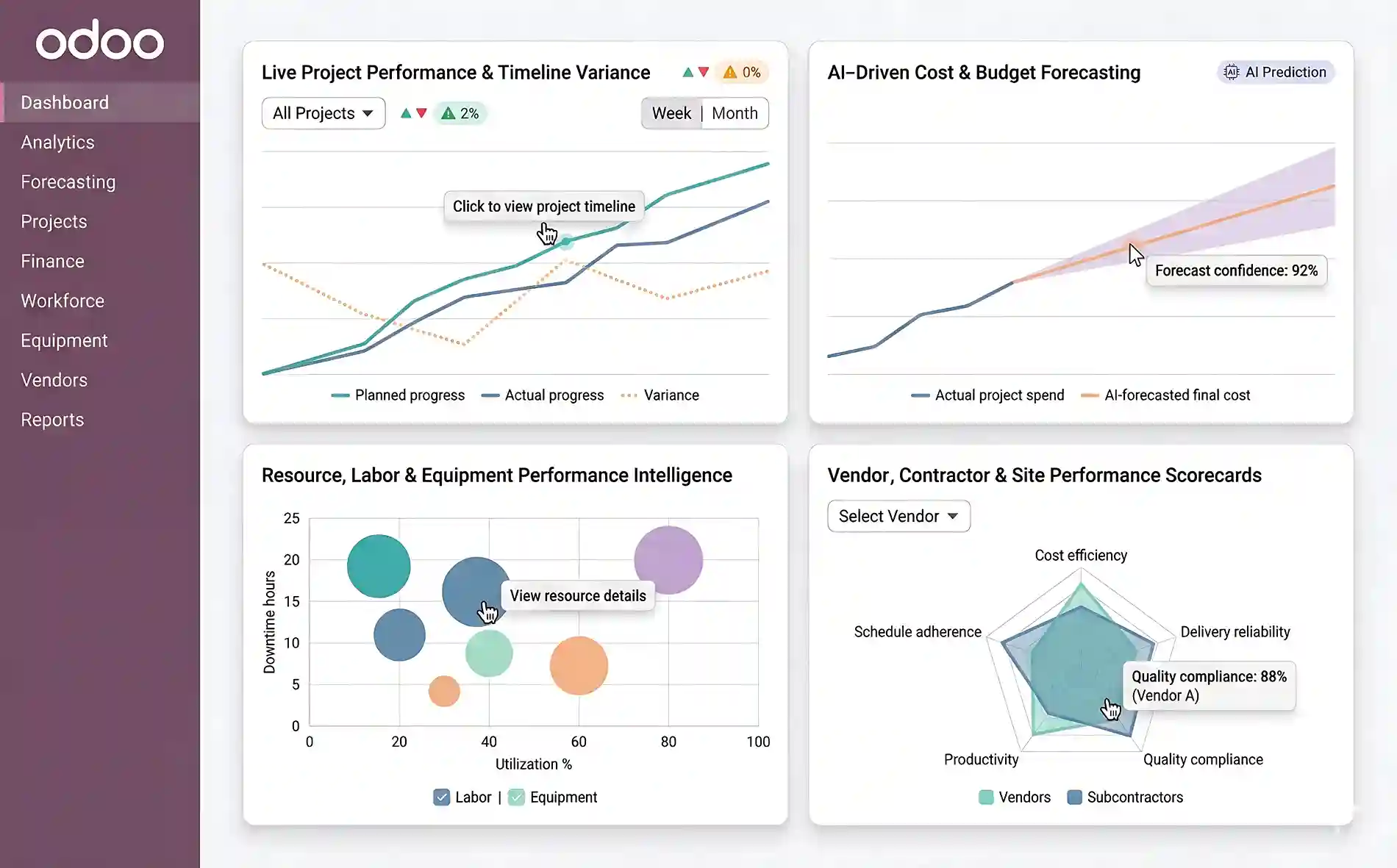
Odoo for Construction delivers real-time visibility into budgets, resources, schedules, equipment, and vendor performance through unified dashboards and advanced reporting. By integrating planning, finance, workforce, procurement, and site operations data, Odoo eliminates reporting gaps and enables data-driven decision-making. Construction leaders can identify risks early, optimize workflows, and improve overall project governance.
Real-Time Dashboards for Project, Financial & Operational Performance
Odoo consolidates data from all active projects into interactive dashboards, enabling stakeholders to track critical KPIs at a glance.
Dashboards Provide Insights On
- Project progress and timeline variance
- Budget vs. actual cost comparisons
- Labor productivity and crew performance
- Equipment utilization and downtime
- Procurement and material consumption metrics
- Safety incidents and compliance tracking
Additionally, dashboards are customizable for project managers, financial controllers, and executives.
AI-Powered Forecasting for Budgeting, Scheduling & Resource Allocation
Forecast accuracy directly impacts construction profitability. Odoo uses predictive analytics to support smarter decisions.
AI Forecasting Capabilities
- Predicting schedule delays based on historical patterns
- Forecasting labor requirements for upcoming phases
- Estimating equipment availability and maintenance needs
- Cost projection based on real-time consumption trends
- Identifying high-risk areas within the project plan
Consequently, managers can mitigate risks early and maintain better control over timelines and budgets.
Performance Intelligence for Evaluating Vendors, Contractors & Site Teams
Poor vendor performance or subcontractor delays can cascade into major project setbacks. Odoo provides actionable intelligence across all project contributors.
Performance Insight Capabilities
- Vendor scorecards based on pricing, delivery time & quality
- Subcontractor performance tracking with KPIs
- Labor productivity metrics per site or phase
- Material wastage and efficiency analytics
- Delay analysis with root-cause insights
Moreover, these insights help improve vendor selection and strengthen negotiation leverage.
Automated Reporting & Audit-Ready Compliance Documentation
Construction companies must generate reports for clients, regulators, investors, and internal stakeholders. Odoo automates these reporting workflows to save time and reduce errors.
Reporting Tools Include
- Daily progress reports (DPRs)
- Weekly and monthly project summaries
- Budget utilization and cost variance reports
- Safety and compliance reports
- Procurement and inventory consumption summaries
- Client-ready milestone and completion reports
Additionally, Odoo maintains complete audit trails, ensuring transparency and regulatory compliance.
7. Workforce & Document Management with Odoo for Construction
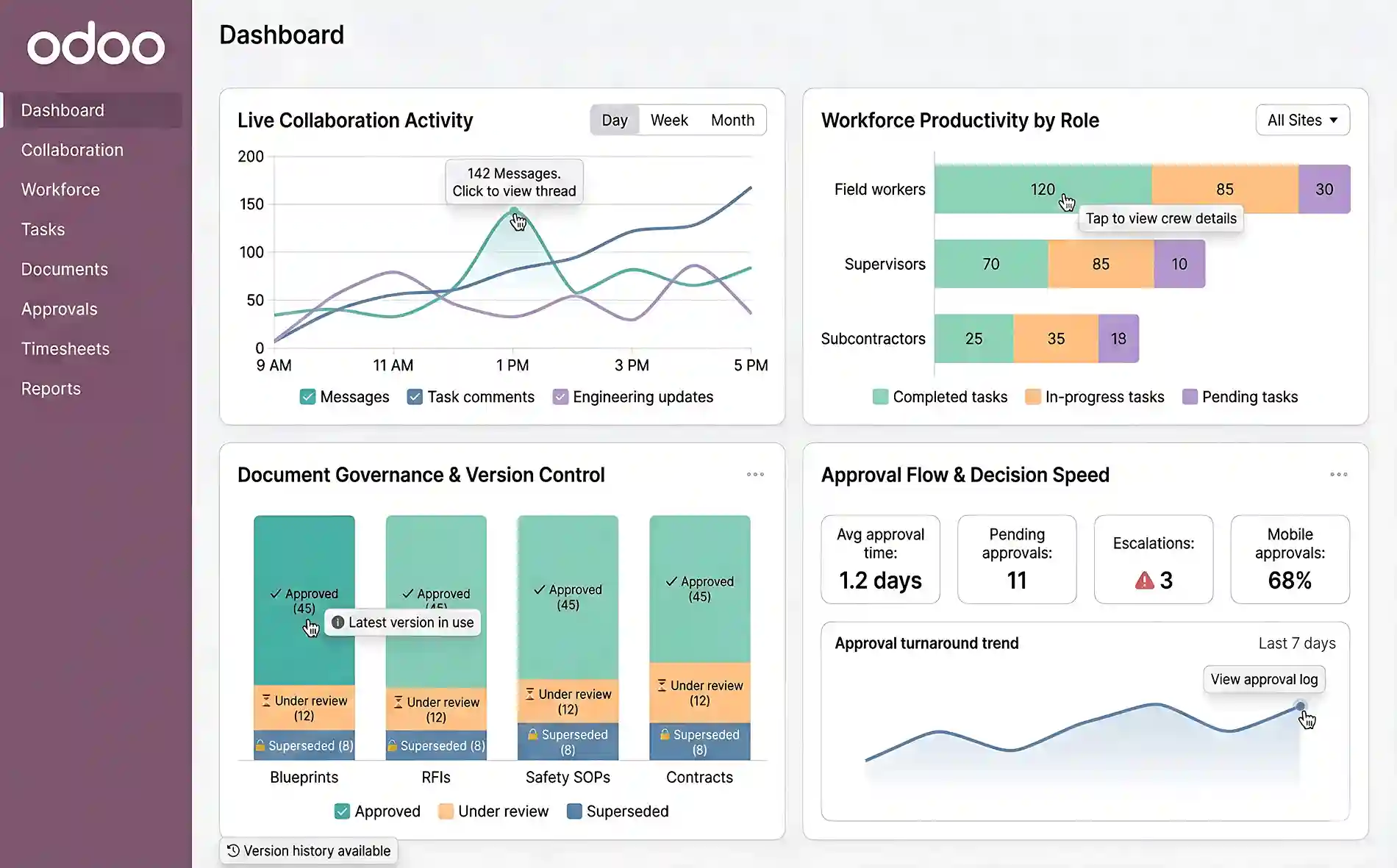
Odoo improves project collaboration by connecting field workers, engineers, subcontractors, and project managers on a single platform. By centralizing documents, real-time updates, and task coordination, Odoo reduces miscommunication, prevents delays, and boosts on-site productivity. With mobile access, construction teams always have the latest information available in the field.
Cross-Department Collaboration Connecting Field Teams, Office Staff & Contractors
Odoo eliminates communication silos by centralizing all project conversations, instructions, updates, and approvals.
Collaboration Enhancements
- In-app messaging and @mentions for instant coordination
- Task-specific discussion threads for clarity
- Automated notifications for schedule updates and changes
- Communication logs for transparent decision-making
- Shared visibility of project progress for all stakeholders
Additionally, engineering changes, material updates, and task priorities can be communicated instantly to site workers without delays.
Workforce Productivity Tools for Optimizing Site Operations
Construction crews require clear task assignments, resource visibility, and simplified reporting tools. Odoo improves productivity through structured workflows.
Productivity Capabilities
- Daily task lists for workers, foremen, and subcontractors
- Workload balancing based on project phase
- Timesheet tracking and integration with payroll
- Performance dashboards for evaluating teams
- Attendance logs linked to project activities
Consequently, supervisors can identify bottlenecks early and ensure on-time execution of critical tasks.
Document Governance, Version Control & Blueprint Accuracy
One of the biggest risks in construction projects is using outdated drawings, incorrect specifications, or misplaced documents. Odoo solves this through secure document governance.
Document Control Features
- Centralized repository for drawings, RFIs, specifications & SOPs
- Version control preventing use of outdated documents
- Digital approvals for engineering changes
- Access permissions for sensitive documentation
- Mobile access for on-site teams
A complete overview of this subject is detailed in Using Odoo for Document Control in Construction Projects, which showcases how Odoo prevents costly rework tied to document mismanagement.
Approval Workflow Automation for Faster Decision-Making
Construction involves constant approvals—change orders, material requests, cost variations, subcontractor bills, and schedule updates. Odoo automates these flows to reduce delays.
Approval Workflow Strengths
- Custom routing rules for financial and operational approvals
- Escalation triggers for overdue approvals
- Transparent approval history for audits
- Role-based access control for sensitive decisions
- Mobile approvals enabling on-site managers to respond instantly
Moreover, faster approvals result in smoother project execution and lower administrative overhead.
Traditional vs. Odoo-Driven Construction Collaboration
| Area | Traditional Construction | Odoo for Construction |
|---|---|---|
| Communication | Fragmented tools | Unified collaboration platform |
| Document Control | Risk of outdated files | Secure version-controlled repository |
| Task Management | Manual assignments | Automated workforce planning |
| Productivity Tracking | Limited visibility | Real-time dashboards |
| Approvals | Slow & paper-based | Automated, digital & traceable |
8. Odoo for Construction Supply Chain Optimization & Material Flow Intelligence
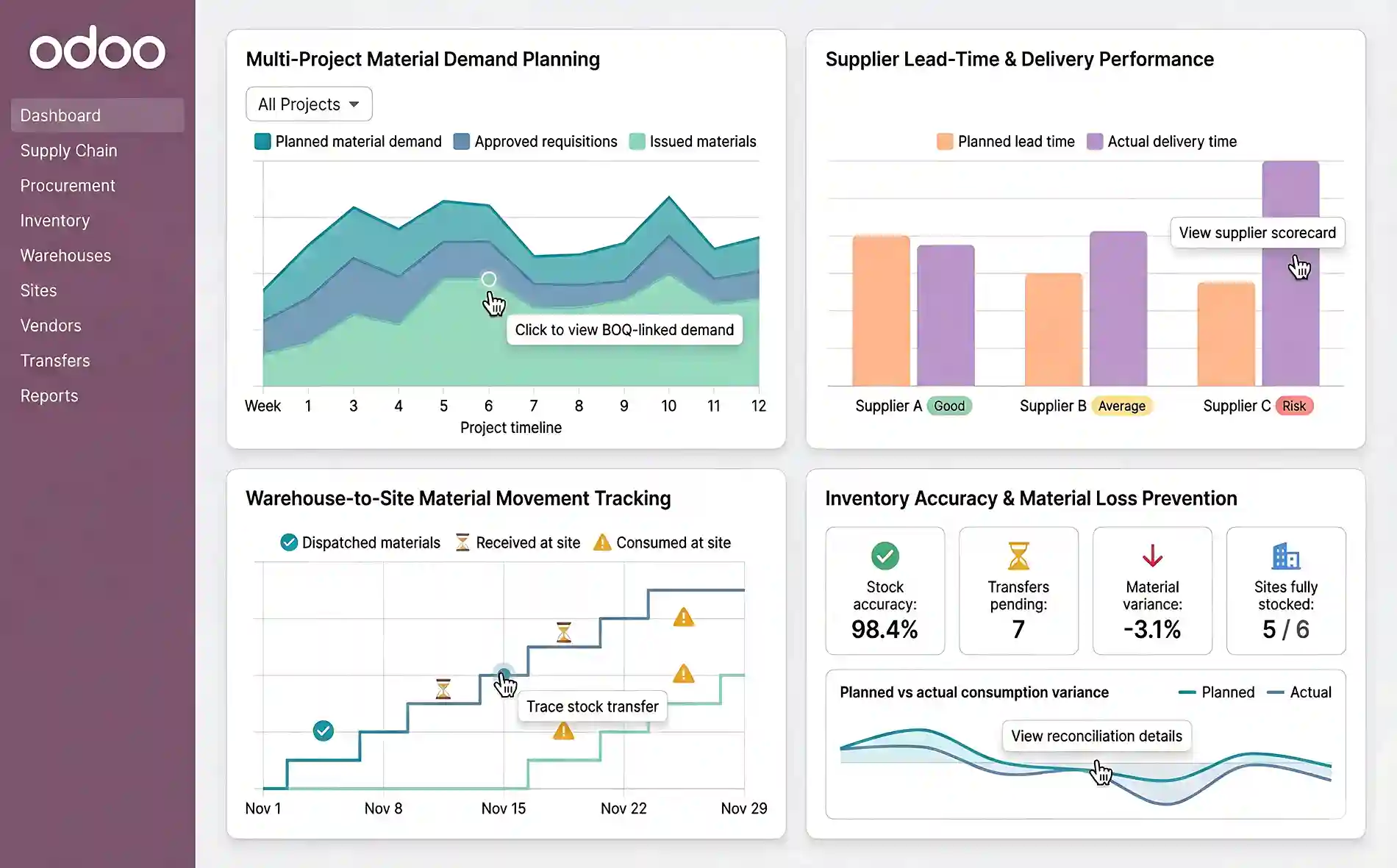
Material mismanagement is one of the leading causes of cost overruns and site delays in construction. Poor coordination between procurement, warehouses, suppliers, and project sites often results in shortages, excess stock, or delivery disruptions. Odoo for Construction introduces a fully integrated supply chain ecosystem that ensures materials reach the right site at the right time, with complete traceability.
Centralized Material Demand Planning Across Multiple Projects
Construction companies handle several sites simultaneously, each with unique material needs. Odoo centralizes planning by:
Forecasting material demand based on project progress
Auto-generating requisitions from site managers
Managing multi-site stock levels in real time
Synchronizing material requirements with approved BOQs
Avoiding duplicate orders across simultaneous projects
Additionally, procurement teams receive early alerts for long lead-time items, preventing workflow stoppages.
Intelligent Supplier Coordination & Lead-Time Optimization
Suppliers and contractors often operate on tight schedules. Odoo optimizes supplier relationships with:
Lead-time analytics for better planning
Vendor scorecards (delivery speed, quality, pricing)
Automated purchase workflows
Supplier portal access for smooth communication
Real-time updates on shipment status
Consequently, material availability becomes predictable, reducing delays and unplanned downtime.
Material Movement Tracking Between Warehouses & Construction Sites
Construction companies often struggle with lost or unaccounted inventory during inter-site transfers. Odoo enables:
Digital tracking of stock transfers
QR/barcode-based dispatch recording
Real-time stock visibility at all sites
Reconciliation of site consumption
Alerts for missing or delayed transfers
This ensures complete traceability, reduces wastage, and improves accountability.
9. Odoo for BIM Integration & Digital Twin Collaboration
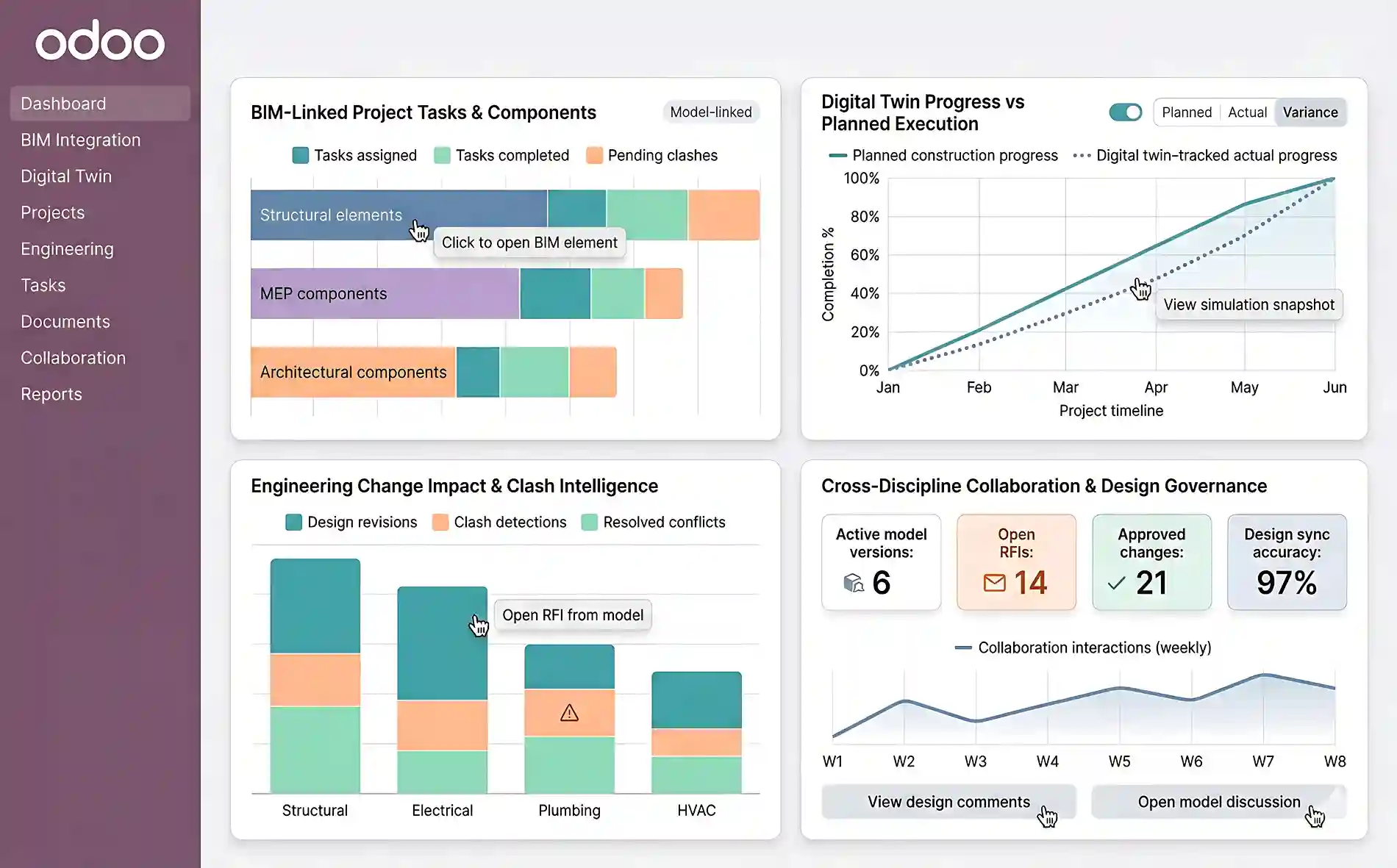
Modern construction is moving toward fully digital project environments powered by BIM models and real-time simulations. Odoo for Construction bridges ERP workflows with BIM ecosystems, enabling stronger data-driven engineering coordination.
3D Model-Linked Project Workflows for Engineering Precision
Integrating BIM models with Odoo helps teams connect the physical structure with operational data:
Linking tasks with BIM components
Auto-generating material quantities from BIM
Real-time updates to reflect design revisions
Clash detection insights flowing into project tasks
Improved coordination between architects & site engineers
Additionally, the integration ensures construction happens exactly as designed, minimizing rework.
Digital Twin Monitoring for Large-Scale Construction Projects
Digital twin models allow companies to simulate, track, and optimize their projects virtually.
Digital Twin Capabilities Include
Real-time representation of site progress
IoT-enabled monitoring of structural elements
Predictive analysis for construction sequencing
Visualization of delays and resource bottlenecks
Comparison between planned vs. actual progress
This advanced capability helps executives make quicker, data-driven decisions.
Cross-Discipline Collaboration with Engineers, Architects & Contractors
BIM integration strengthens alignment across project stakeholders.
Collaboration Enhancements
Centralized version control for design updates
Shared documentation for MEP, structural & architectural layers
Automated change notifications
Commenting tools for cross-team coordination
Digital RFI workflows linked directly to model elements
Moreover, design conflicts are resolved early saving both time and cost.
Conclusion
Odoo for Construction provides contractors and infrastructure companies with a unified ERP platform to manage projects, workforce coordination, budgeting, equipment tracking, and compliance in real time. To ensure a successful and scalable implementation, organizations can partner with SDLC Corp and explore expert Odoo Consulting Services for tailored solutions that deliver improved cost control, visibility, and on-time project delivery.
FAQ's
Why is SDLC Corp the best choice for Odoo for Construction implementation?
SDLC Corp offers extensive experience, industry-specific knowledge, and technical excellence in Odoo deployments. Their proven consulting methodology, strong project governance, and successful real-world implementations make them the ideal partner for construction companies seeking scalable, reliable digital systems.
What are the main benefits of using Odoo for Construction?
Odoo streamlines project scheduling, equipment tracking, budgeting, procurement, document control, and field coordination. This reduces delays, improves productivity, enhances cost accuracy, and strengthens visibility across all construction phases.
Can Odoo help reduce delays in construction projects?
Yes. Odoo’s scheduling tools, task dependencies, alerts, and real-time dashboards help teams identify bottlenecks early and maintain execution discipline. A deeper exploration is available in Reducing Construction Delays with Odoo Scheduling Tools.
How does Odoo support equipment tracking and maintenance in construction?
Odoo offers real-time equipment usage logs, GPS/IoT integration, predictive maintenance scheduling, and site-level allocation tracking. These capabilities are explained further in Odoo Solutions for Equipment Tracking in Construction.
Does Odoo improve document control and blueprint management?
Absolutely. Odoo centralizes drawings, RFIs, specifications, and contracts with robust version control and secure access permissions. Details are covered in Using Odoo for Document Control in Construction Projects.
Can Odoo manage construction budgets and cost control effectively?
Yes. Odoo integrates project operations with accounting, enabling real-time cost tracking, variance analysis, forecasting, and financial reporting. Learn more in Tracking Construction Project Budgets Using Odoo Accounting.
How does Odoo enhance daily field operations and team coordination?
Odoo provides mobile-ready daily logs, task assignments, communication threads, timesheets, workforce scheduling, and incident reporting ensuring high productivity and instant visibility for supervisors and project managers.




